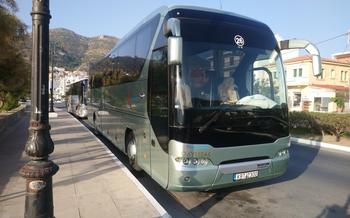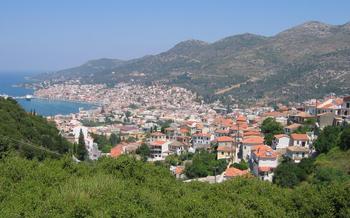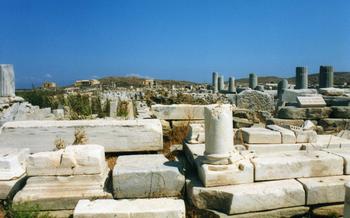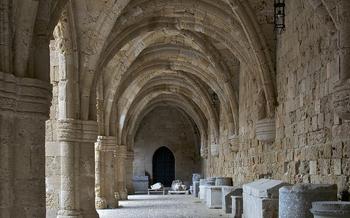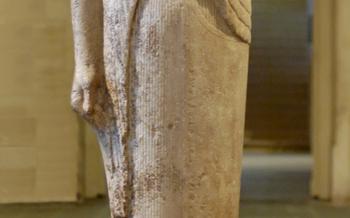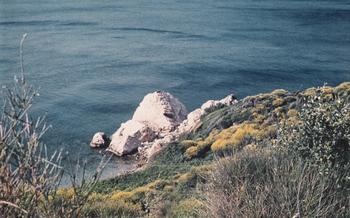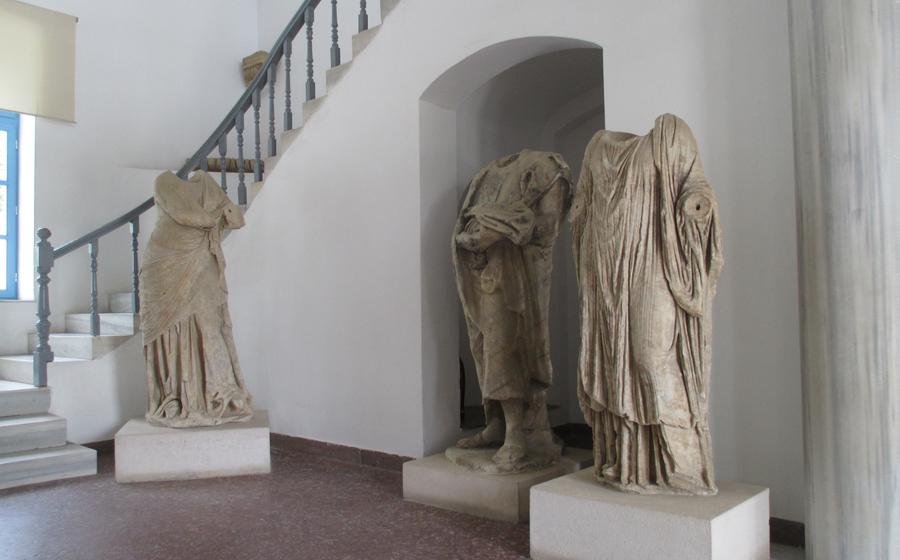
Archaeological Museum of Samos
- A Journey Through Time
- Location and Accessibility
- First Impressions
- Permanent Exhibitions
- Ancient Sculptures
- Mosaics and Frescoes
- Religious Artifacts
- Ceramics and Pottery
- Tools and Implements
- Coins and Currency
- Jewelry and Adornments
- Fun for Kids
- Educational Programs
- Museum Shop
- Insider Tip
A Journey Through Time
The Archaeological Museum of Samos takes visitors on a captivating journey through the annals of this storied island's past. Established in 1987, the museum houses a treasure trove of artifacts that illuminate the rich cultural heritage and artistic prowess of ancient Samos. From imposing statues and intricate friezes to delicate pottery and everyday tools, the museum's diverse collection offers a glimpse into the lives and achievements of the ancient Samians, who left an indelible mark on the region's history.
Highlights of the Museum's Collection
Among the museum's highlights are the impressive marble statues of Kouros and Kore, dating back to the Archaic period. These life-size sculptures exude an air of serenity and elegance, showcasing the mastery of ancient Greek sculptors in capturing the human form. Equally captivating are the Hellenistic friezes depicting scenes from Greek mythology, providing a glimpse into the religious beliefs and storytelling traditions of the ancient world.
Significance of the Museum for Understanding the Island's Past
The Archaeological Museum of Samos plays a pivotal role in preserving and showcasing the island's rich cultural heritage. Through its comprehensive collection, the museum offers visitors a profound understanding of the historical, artistic, and cultural developments that shaped ancient Samos. Whether you are a history buff, an art enthusiast, or simply curious about the island's past, a visit to the Archaeological Museum is a must to delve into the heart and soul of Samos.
Location and Accessibility
The Archaeological Museum of Samos is conveniently located in the picturesque town of Vathy, the capital of the island. Situated on the waterfront, the museum is a short walk from the main square and the picturesque harbor. Visitors can easily reach the museum on foot, by bike, or by car. The museum's address is Leoforos Ethnikis Antistaseos 1, Vathy 831 00, Samos, Greece.
The Archaeological Museum of Samos is open to the public from Tuesday to Sunday during the summer months (April 1st to October 31st) from 8:00 am to 3:00 pm. In the winter months (November 1st to March 31st), the museum is open from Tuesday to Friday from 8:00 am to 2:30 pm.
Admission fees are affordable, with tickets costing around €3 for adults and €2 for students and seniors. Children under the age of 6 are admitted free of charge.
Visitors arriving by car can find ample parking spaces along the waterfront or in the nearby streets. For those using public transportation, there are several bus stops within walking distance of the museum.
First Impressions
Upon entering the Archaeological Museum of Samos, visitors are immediately struck by its impressive architectural style and design. The building itself is a testament to the island's rich history and cultural heritage, showcasing a blend of traditional and modern elements. The exterior facade features intricate stonework and decorative motifs that hint at the treasures within.
Inside, the atmosphere is one of awe and wonder, as visitors are greeted by a spacious and well-lit exhibition space. The layout is designed to guide visitors through a chronological journey, starting from the Archaic period and continuing through to the Hellenistic and Roman eras. Each section is carefully curated, with artifacts arranged in a manner that allows visitors to appreciate their significance and context.
Permanent Exhibitions
The Archaeological Museum of Samos boasts an impressive collection of artifacts arranged chronologically, taking visitors on a journey through the island's rich history. The exhibits cover a vast timeline, from the Archaic period to the Hellenistic era, offering a comprehensive glimpse into the artistic, cultural, and societal evolution of Samos.
Among the highlights of the Archaic period are stunning marble statues, such as the famous Kouros of Samos, which exemplifies the transition from Egyptian to Greek sculptural styles. Visitors can also admire intricate ceramic vessels adorned with geometric and floral motifs, reflecting the island's thriving pottery industry.
The Classical period is represented by a collection of finely crafted sculptures, including well-preserved statues of gods and goddesses, as well as reliefs depicting scenes from mythology and daily life. These works showcase the mastery of ancient Greek sculptors and provide valuable insights into religious beliefs and practices.
Moving into the Hellenistic era, the museum displays a range of artifacts that demonstrate the influence of Greek culture on the wider Mediterranean region. Exquisite jewelry, delicate figurines, and elegant pottery adorned with intricate designs testify to the artistry and craftsmanship of the Hellenistic period.
Ancient Sculptures
Among the highlights of the museum's collection are the impressive array of ancient sculptures that offer a glimpse into the artistic prowess of the Samians. These statues, reliefs, and friezes, crafted from marble, bronze, and terracotta, showcase the remarkable skills of the island's artisans and the diverse artistic influences that shaped their work.
One of the most captivating sculptures is the kouros, a life-size statue of a young man dating back to the Archaic period. With its serene expression, idealized features, and intricate details, this kouros embodies the transition from the rigid forms of the earlier Archaic style to the more naturalistic representations of the Classical era.
Another highlight is the Victory of Samothrace, a marble statue depicting the goddess Nike perched on the prow of a ship. Originally created to commemorate a naval victory, this masterpiece captures the dynamic movement and triumphant spirit of the goddess, embodying the prowess of the Samians as a seafaring nation.
The museum also displays an impressive collection of reliefs and friezes that adorned public buildings and temples throughout the island. These intricate carvings depict mythological scenes, historical events, and religious rituals, providing valuable insights into the beliefs and practices of ancient Samian society.
Mosaics and Frescoes
Among the many treasures housed within the Archaeological Museum of Samos, the collection of mosaics and frescoes stands out for its exquisite beauty and historical significance. These vibrant and intricate artworks, meticulously crafted by skilled artisans, offer a glimpse into the artistic prowess and cultural heritage of ancient Samos.
One of the most remarkable mosaics on display is a stunning depiction of Dionysus, the Greek god of wine and revelry. The mosaic, composed of thousands of tiny tesserae, portrays Dionysus seated upon a throne, surrounded by his entourage of satyrs and maenads. The god's radiant figure exudes an aura of divine majesty, while the surrounding figures are captured in poses of exuberant celebration.
Another highlight of the museum's collection is a series of well-preserved frescoes, which adorn the walls of several rooms. These frescoes, painted using vibrant pigments on a layer of plaster, depict a variety of scenes from Greek mythology and everyday life. One particularly captivating fresco portrays a group of musicians performing at a symposium, capturing the essence of ancient Greek social gatherings.
The mosaics and frescoes in the Archaeological Museum of Samos provide a vivid testament to the artistic achievements of the ancient Samians. These artworks, with their intricate designs and vibrant colors, transport visitors back in time, offering a glimpse into the rich cultural tapestry of this remarkable island.
Religious Artifacts
The Archaeological Museum of Samos houses an impressive collection of religious artifacts, offering a glimpse into the spiritual beliefs and practices of ancient Samians. Among the notable exhibits are statues and votive offerings dedicated to various deities, providing insight into the religious landscape of the island.
Statues of gods and goddesses, meticulously crafted from marble or bronze, stand as testaments to the artistic prowess of ancient sculptors. These deities, with their distinct attributes and iconography, reveal the diverse religious pantheon worshipped by the Samians. From the majestic Zeus, king of the gods, to the graceful Hera, goddess of marriage and childbirth, each statue embodies the essence of a divine figure.
Votive offerings, ranging from small terracotta figurines to elaborate marble reliefs, further illuminate the religious practices of ancient Samos. These offerings, often dedicated to specific deities in gratitude for answered prayers or protection, provide a tangible connection to the personal devotions of the island's inhabitants.
The museum's collection of religious artifacts not only showcases the artistic achievements of ancient Samos but also sheds light on the deep-rooted spiritual beliefs that shaped the lives of its people. Through these sacred objects, visitors can gain a deeper understanding of the religious rituals, customs, and traditions that permeated ancient Samian society.
Ceramics and Pottery
The Archaeological Museum of Samos boasts a rich collection of pottery from various periods, providing a comprehensive overview of the island's ceramic heritage. These artifacts showcase the diverse styles, techniques, and decorative motifs that characterized Samian pottery throughout the ages.
Among the highlights of the collection are exquisite examples of Archaic pottery, known for its geometric patterns and stylized human and animal figures. These vessels, often used for storage or as drinking cups, demonstrate the early artistic prowess of Samian potters.
In contrast, the Classical period saw the emergence of more naturalistic and intricate designs, as evidenced by the numerous red-figure and black-figure vases on display. These finely crafted works depict scenes from mythology, everyday life, and religious rituals, offering a glimpse into the cultural and artistic milieu of ancient Samos.
The Hellenistic period witnessed further innovations in ceramic production, with the introduction of new techniques such as glazing and the use of molds. The museum's collection includes stunning examples of Hellenistic pottery, showcasing intricate relief decoration and a wide range of colors.
Whether it's the delicate artistry of Archaic pottery, the narrative richness of Classical vases, or the technical sophistication of Hellenistic ceramics, the Archaeological Museum of Samos offers a comprehensive journey through the history of this ancient art form.
Tools and Implements
The Archaeological Museum of Samos offers a fascinating glimpse into the daily lives of ancient Samians through its collection of tools and implements. These everyday objects, crafted with skill and ingenuity, provide a tangible connection to the past and shed light on the practical aspects of life in ancient Greece.
From humble farming tools to sophisticated surgical instruments, the museum's collection encompasses a wide range of objects that were essential for various tasks and activities. Visitors can marvel at the intricate designs of bronze arrowheads, the sturdy construction of iron plowshares, and the delicate precision of surgical scalpels. These artifacts offer a glimpse into the agricultural practices, hunting techniques, and medical knowledge of the ancient Samians.
In addition to tools used for work, the museum also displays a variety of household implements that provide insight into domestic life. Cooking utensils, such as bronze pots and pans, illustrate the culinary practices of the time, while oil lamps and candlesticks illuminate the challenges of providing light in a world without electricity. Visitors can also admire the intricate designs of jewelry and personal adornments, which reveal the aesthetic sensibilities and craftsmanship of ancient Samians.
These tools and implements, though often overlooked, are essential for understanding the daily realities of life in ancient Greece. They offer a glimpse into the ingenuity, resourcefulness, and creativity of the ancient Samians, and provide a deeper appreciation for their rich and complex culture.
Coins and Currency
The Archaeological Museum of Samos boasts a remarkable collection of ancient coins, offering a fascinating glimpse into the economic and monetary systems of the island's past. These coins, minted on Samos from the 6th century BC onwards, showcase a variety of designs and symbols, reflecting the island's rich history and cultural influences.
Visitors can marvel at the intricate artistry and detailed motifs adorning these ancient coins, each one a testament to the skill and craftsmanship of the Samian engravers. The collection includes silver and bronze coins, ranging from small denominations used in everyday transactions to larger, more valuable pieces that may have been used for special occasions or as commemorative issues.
Through these coins, visitors can trace the evolution of Samian coinage over the centuries, from the early electrum staters to the later silver and bronze issues. The designs on the coins often depict local deities, mythological figures, or symbols associated with the island, providing valuable insights into the religious and cultural beliefs of ancient Samos.
The museum's collection of coins also sheds light on the island's economic activities and trade relations. Samos was an important trading hub in the ancient world, and its coins were widely used throughout the Mediterranean region. The presence of coins from other cities and regions within the museum's collection attests to the island's extensive commercial network.
Overall, the coins and currency on display at the Archaeological Museum of Samos offer a tangible connection to the island's rich past and provide a unique perspective on its economic and cultural development.
Jewelry and Adornments
The Archaeological Museum of Samos boasts an impressive collection of jewelry and adornments, offering a glimpse into the personal adornment practices of the ancient Samians. Exquisite necklaces, earrings, bracelets, and rings, crafted from gold, silver, and bronze, showcase the remarkable skill and artistry of the island's craftsmen. Intricate designs, delicate filigree work, and the use of precious and semi-precious stones add to the allure of these beautiful objects.
Beyond their aesthetic appeal, these adornments held deep symbolic and cultural significance. Jewelry was often used as a symbol of status, wealth, and power, with different types of jewelry reserved for specific occasions or social classes. Earrings, for instance, were commonly worn by both men and women, while necklaces and bracelets were often given as gifts to mark special events such as weddings or religious festivals.
One of the highlights of the collection is a stunning gold necklace adorned with intricate filigree work and delicate pendants. Another remarkable piece is a pair of gold earrings featuring intricate granulation work, a technique that involves fusing tiny gold beads together to create a textured surface. These exquisite artifacts, along with many others, provide a fascinating glimpse into the personal adornment practices and cultural traditions of ancient Samos.
Fun for Kids
The Archaeological Museum of Samos offers a range of interactive exhibits and activities designed to engage young visitors and make their museum experience both enjoyable and educational. Children can participate in hands-on activities such as pottery painting, mosaic making, or dressing up in ancient Greek costumes. These activities not only provide entertainment but also help kids learn about the history and culture of ancient Samos in a fun and interactive way.
To keep the younger ones entertained, the museum has set up a dedicated children's corner with puzzles, games, and interactive displays that teach them about archaeology and ancient Greek mythology. The museum also organizes regular workshops and events specifically tailored for children, such as storytelling sessions, art classes, and treasure hunts. These events are a great way for kids to learn about history while having fun and making new friends.
Educational Programs
The Archaeological Museum of Samos offers a range of educational programs to enhance the visitor experience and facilitate deeper engagement with the exhibits. Guided tours, led by knowledgeable museum guides, provide insightful commentary and historical context to the artifacts on display. These tours are available in various languages and can be tailored to specific interests or age groups.
The museum also hosts workshops and lectures throughout the year, inviting experts and scholars to share their knowledge on various aspects of Samian history, archaeology, and culture. These events offer a unique opportunity to learn from leading authorities in the field and gain a deeper understanding of the island's rich heritage.
For schools and educational groups, the museum offers tailored programs that align with their curriculum. Interactive activities, hands-on experiences, and educational materials are designed to make learning about ancient Samos both enjoyable and effective.
Overall, the educational programs at the Archaeological Museum of Samos provide a valuable resource for visitors of all ages, fostering a deeper appreciation for the island's cultural legacy and inspiring a lifelong interest in the wonders of the ancient world.
Museum Shop
The Archaeological Museum of Samos offers a well-stocked museum shop where visitors can purchase a variety of souvenirs and educational resources to commemorate their visit. The shop features a diverse selection of items, including replicas of ancient artifacts, books on Samian history and culture, and traditional Greek handicrafts. Visitors can find unique gifts for friends and family, such as pottery, jewelry, and textiles inspired by ancient Greek designs. The museum shop also offers a range of educational materials, including children's activity books, puzzles, and replicas of ancient coins, which can help visitors of all ages learn more about the island's rich history.
Insider Tip
Visiting the Archaeological Museum of Samos during off-peak hours, such as early mornings or late afternoons, is recommended to avoid the crowds and enjoy a more tranquil atmosphere. This will allow you to leisurely browse the exhibits and fully appreciate the museum's treasures without feeling rushed.
One hidden gem that often goes unnoticed is the small collection of ancient musical instruments. These rare and fascinating artifacts offer a glimpse into the musical traditions of ancient Samos and provide an auditory connection to the past. Be sure to seek them out and imagine the melodies that once filled the island's air.
